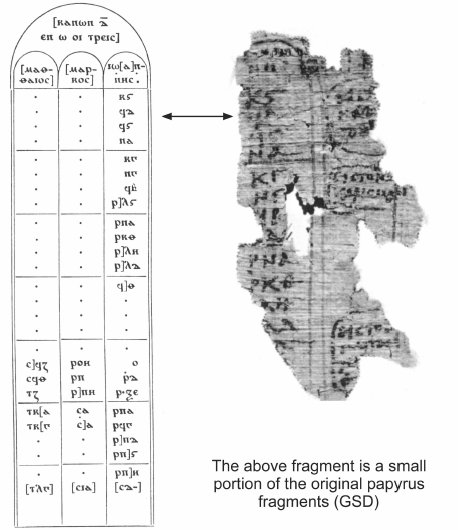5th Century Canon List
with Pericope de Adultera
Background
Taken from: A Tidbit on the Pericope Adulterae,
by Mr. Gary S. Dykes, published online as a .PDF at:
Tidbit on PA < - - .PDF here.
A Tidbit on the Pericope Adulterae
courtesy: Mr. Gary S. Dykes
'Typically the older Alexandrian MSS omit Jn 7:53-8:11, a text known as the "Pericope Adulterae", or reposition it elsewhere.
For what its worth, I present this interesting piece of information, here, as it is often overlooked.
It concerns some papyrus fragments from Egypt, published in 1926 in:
The Monastery of Epiphanius at Thebes, Publications of the Metropolitan Museum of Art, N.Y. Walter Crum and H. E. Winlock. H. G. Evelyn-White edited these fragments in volume 2.
The fragments received more attention in 1982 in DUMBARTON OAKS PAPERS: Number Thirty-Six. IN an article by Carl Nordenfalk (pages 29-38), with full fascimiles.
These are fragments of Gospel Canon Tables! Found in/near the tomb of Daga (Between Medinet-Habu and the Valley of the Kings).
There in the 6th century Epiphanius took up residence. Found amongst his personal papers were a Gospel Book, with the Eusebian Harmony, the present fragments.
The fragments date in the 6th century or a bit earlier, possibly 450-550 A.D. It is to be noted in the small portion (reproduced below) of the 15 fragments, that in John an extra digit is added to the usual sequence. This is explained in Nordenfalk's own words:
'...all the numbers in the row for John are, from some number after 70 and before 91, one digit ahead of the normal sequence. Ther can be only one explanation. The Gospel text must have contained the pericope of the Woman Taken in Adultery (John 7:53-8:11), which was absent in the Gospel Book of Eusebius as well as in practically all the oldest codices which have been preserved. Not only was it included in our manuscript, but also, and more unusually, it was given a section number of its own, with the result that all the following sections had to be renumbered.'
For a full explanation, I suggest you see the full article in DOP, number 36, 1982. From which the above quote comes.
- Gary S. Dykes
Reconstructed Canon List & Fragment
